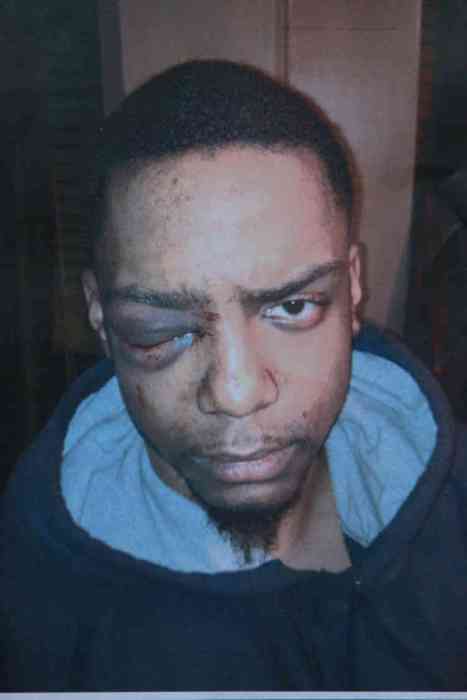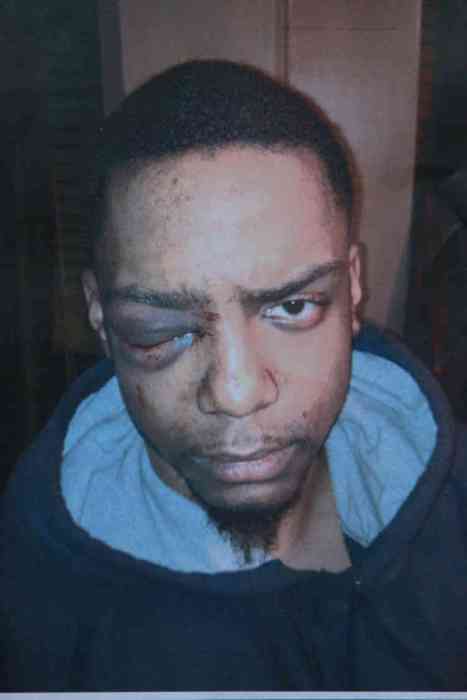Mayer Herskovic being escorted from a courtroom in State Supreme Court in Brooklyn after being found guilty. last fall. | JB NICHOLAS
Even as they conceded that DNA evidence “is a very powerful, and very valuable, law enforcement tool,” the attorneys who won Mayer Herskovic’s release from custody less than three hours after his sentencing attacked the method used to analyze the DNA evidence that was key to his conviction.
“Mayer Herskovic is an innocent man,” Stuart Slotnick said on March 16 after Herskovic was sentenced for his role in the 2013 assault. “We think the DNA evidence was completely and totally flawed.”
Herskovic, 24, was convicted of second-degree gang assault, menacing, and unlawful imprisonment in the 2013 attack on Taj Patterson, 25, in Williamsburg. Patterson, a black gay man, was left blind in one eye in the assault. Danny Chun, the judge who heard the non-jury trial, sentenced Herskovic to four years in prison.
Herskovic’s lawyers question DNA evidence, but was it really just old-fashioned clout?
Following the sentencing, Slotnick, along with Donna Aldea, a partner at Barket Marion Epstein Kearon LLP delivered a 46-page motion to a state appellate judge that suggested that the DNA found on a crucial piece of evidence might not have been Herskovic’s and even if it were Herskovic’s DNA, it may have ended up on Patterson’s sneaker by some method other than Herskovic touching the sneaker.
“Even assuming that Mayer’s DNA was present on the heel of the shoe, there would be no way to know if it got there from Mayer touching the shoe, and thereby leaving a few skin cells behind, or from Patterson stepping on the street where Mayer had spit earlier in the day, or on some other day,” Aldea wrote in the motion.
Patterson was set upon by roughly 20 men, some of whom belonged to a neighborhood patrol organized by the Satmar community. The Satmar are part of the Hasidic sect of Orthodox Judaism. The men first pursued Patterson along Flushing Avenue in cars and on foot. Once caught, Patterson was punched and kicked, had a thumb jammed in his eye, and was knocked to the ground.
No witness identified Herskovic as the man who led the attack. The core of the case was Herskovic’s DNA on Patterson’s sneaker, which police recovered from the roof of a low building next to where the young man was assaulted. Patterson testified that the man who punched him, jabbed a thumb in his eye, and kicked him in the face as he lay on the ground was the same man who pulled off his sneaker and tossed it onto the building. A second witness testified that she saw a man in the crowd throw something on to the roof of a nearby building.
The tiny amount of DNA, 97.9 picograms, was first induced by technicians in the city medical examiner’s office to make copies of itself, a process called amplification, and then compared to known samples of DNA from Herskovic and Patterson.
A picogram is a trillionth of a gram and could be as little as five or six skin cells. The DNA evidence was processed by the city medical examiner’s office in a type of testing called high sensitivity or low copy number DNA testing. While many labs in the US do high sensitivity DNA testing, the city medical examiner is the only lab in the US that uses the method to produce evidence in criminal trials.
Aldea suggested that the amplification process could have introduced errors into the DNA sample because it requires three additional amplification cycles. Any errors introduced could not introduce Herskovic’s DNA into a sample if it were not already in that sample, and any errors created by the amplification could only lessen the likelihood that the DNA there would be found.
The medical examiner then analyses the data with its Forensic Statistical Tool, which is proprietary software that produces a ratio showing the likelihood that a particular individual contributed to the sample.
“The reliability of High Sensitivity testing has recently been seriously questioned by courts and experts,” Aldea wrote. “Profiles created with high sensitivity analysis are deemed unsuitable for upload in the national CODIS databank; the FBI lab, among others, refuses to use it; and it has been denied admissibility in at least two recent criminal cases.”
A far larger number of New York courts have admitted DNA evidence produced with this method, though the city medical examiner’s office has stopped using high sensitivity testing.
“OCME ceased [low copy number] testing in early 2017 after implementing new technologies that align with revised FBI standards for DNA testing and provide enhanced power of identification,” the medical examiner’s office said in a statement. “We stand fully behind our LCN procedures while we are also committed to staying on the cutting edge of new technology to best serve New York City.”
While the federal courts regularly release white collar defendants while they appeal a conviction, it is far less common in New York state courts.
“In my experience, in state court, it’s very uncommon,” said Frank A. Bress, a professor at New York Law School who teaches criminal procedure. “In federal court, it’s much more prevalent…In state court, it’s very rare.”
While Herskovic was convicted of a violent felony, he does not appear to be a flight risk. During the trial, he made all his court appearances while out on bail. With Chun’s permission, he even traveled to a foreign country for a wedding and returned to the US.
The other explanation for Herskovic’s quick release is that he is a member of a politically connected community – the Satmar – and the courts are favoring him.
“The state courts are political as hell,” said Eugene O’Donnell, a former prosecutor in Brooklyn and Queens who teaches criminal law. “It’s a very powerful community. There are different communities that have power, and that is one of the communities that has power.”
Bress and O’Donnell said that Herskovic’s appeal may have substance, but O’Donnell added that the release needed a closer look.
“It could be meritorious, but it deserves enhanced scrutiny,” he said.

































